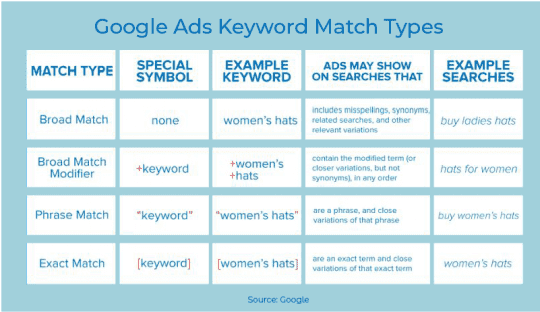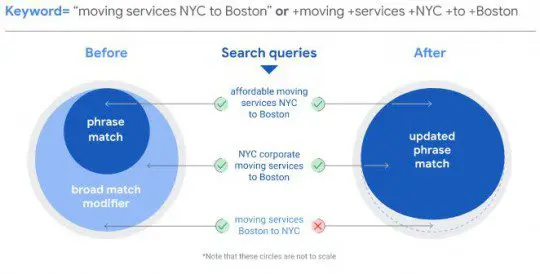In February 2021 Google announced the rollout of a huge change to the how their Google Ads keyword match types work. The way users searches are matched to keywords was going to change, impacting millions of Google Ads campaigns around the world.
Read on to learn what keyword match types are and how this change may affect your business’s Google Ads campaign.
What are Google Ads keyword match types?
Each keyword added to your Google Ads campaign is assigned a match type to designate how closely a user’s Google search should match it in order to trigger your related ad.
Prior to Google’s recent update, there were four distinct keyword match types: Broad Batch (designed to achieve wide reach), Broad Match Modified (for reach with more accuracy), Phrase Match (for more accurate targeting), and Exact Match (for precise targeting).
See the table below showing examples of how symbols denote different match types, and which searches these match types may show ads for. N.B: While not technically a match type, Negative Keywords aren’t covered — these are used to specify searches that you don’t want your ads visible for.

How have Google Ads keyword match types changed?
In February 2021, Google started rolling out a change that saw Phrase Match updated to include some of the behaviour of Broad Match Modifier (BMM), with the latter being put out to pasture.
The updated Phrase Match now covers searches with additional words included (searches BMM would previously have covered), while respecting the word order when it’s important to the meaning of the search (which BMM didn’t).
Google’s infographic below provides an example of how keyword “moving services NYC to Boston” using the updated Phrase Match will target searches with additional words like “NYC corporate moving services to Boston”, but because the word order is important in this case it won’t target searches featuring the words in a different order, like “moving services Boston to NYC”.

Why did Google change the keyword match types?
Citing improvements to their understanding of search intent gained over the years and the ability of Google Ads to better recognise the meaning of a search rather than merely matching the individual words, Google reported that Phrase Match and BMM were often serving the same use cases, and that more of the right customers could be reached through a combination of the two match types.
In their announcement they listed more control and better reach as two of the benefits of updating Phrase Match. By using the improved Phrase Match, they say reaching the searches you want without worrying about the searches you don’t want will be easier.
They also mentioned the change will streamline keyword management, saving campaign managers time.
Does this change affect your Google Ads campaign?
From July 2021, Phrase and BMM keywords will have the same updated phrase matching behaviour for Google Ads campaigns in all languages and adding of new BMM keywords won’t be allowed. Note that these changes have not and will not affect Broad Match and Exact Match keywords, or Negative keywords.
If you’re reading this your Google Ads campaign is likely in English and both your Phrase Match and BMM keywords will already be running with the same updated phrase matching behaviour.
Do you or your digital marketing partner need to make any changes to your keywords?
No specific actions were necessary to see the match type changes take effect and while the rollout isn’t yet complete, we’ve been monitoring our clients’ campaigns closely, watching for any related impact.
So far, we haven’t identified any performance trends off the back of the change. That said, we’ll continue observing the new match type behaviour and how it relates to our clients’ search targeting ability. If we see a negative performance trend clearly related to the change, we’ll adapt the keyword targeting approach for affected campaigns accordingly.
Are you visible in search results when you need to be?
Pay-per-click advertising and Google Ads specifically is unparalleled when trying to penetrate search engine results pages (SERPs) and gain visibility at the exact moment users are searching for your services. To learn more about the power of Google Ads and the Paid Search channel:
Read our recent blog series: How do I get my business to show up on Google? Part 1 and Part 3.
Or tell us where you want your business to go and we’ll tell you if Google Ads can help you get there.